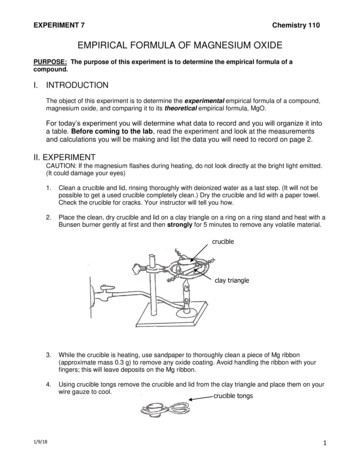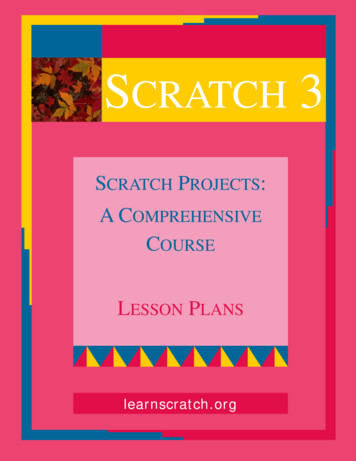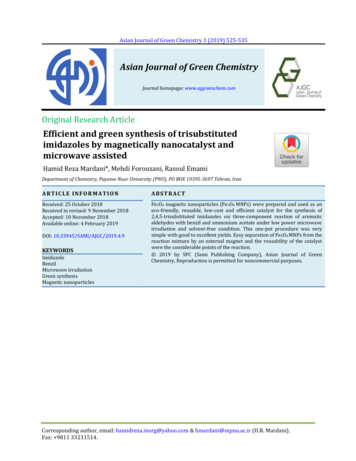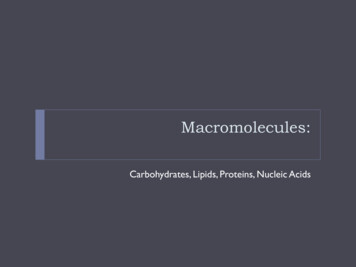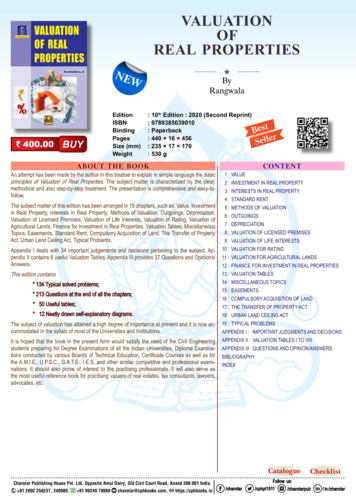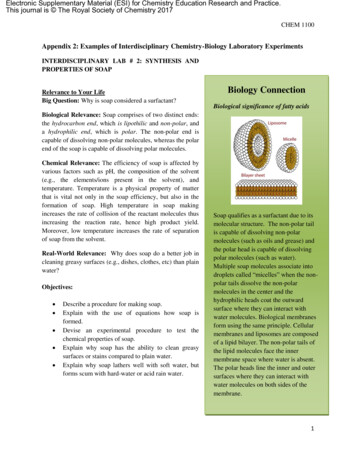
Transcription
Electronic Supplementary Material (ESI) for Chemistry Education Research and Practice.This journal is The Royal Society of Chemistry 2017CHEM 1100Appendix 2: Examples of Interdisciplinary Chemistry-Biology Laboratory ExperimentsINTERDISCIPLINARY LAB # 2: SYNTHESIS ANDPROPERTIES OF SOAPRelevance to Your LifeBig Question: Why is soap considered a surfactant?Biology ConnectionBiological significance of fatty acidsBiological Relevance: Soap comprises of two distinct ends:the hydrocarbon end, which is lipothilic and non-polar, anda hydrophilic end, which is polar. The non-polar end iscapable of dissolving non-polar molecules, whereas the polarend of the soap is capable of dissolving polar molecules.Chemical Relevance: The efficiency of soap is affected byvarious factors such as pH, the composition of the solvent(e.g., the elements/ions present in the solvent), andtemperature. Temperature is a physical property of matterthat is vital not only in the soap efficiency, but also in theformation of soap. High temperature in soap makingincreases the rate of collision of the reactant molecules thusincreasing the reaction rate, hence high product yield.Moreover, low temperature increases the rate of separationof soap from the solvent.Real-World Relevance: Why does soap do a better job incleaning greasy surfaces (e.g., dishes, clothes, etc) than plainwater?Objectives: Describe a procedure for making soap.Explain with the use of equations how soap isformed.Devise an experimental procedure to test thechemical properties of soap.Explain why soap has the ability to clean greasysurfaces or stains compared to plain water.Explain why soap lathers well with soft water, butforms scum with hard-water or acid rain water.Soap qualifies as a surfactant due to itsmolecular structure. The non-polar tailis capable of dissolving non-polarmolecules (such as oils and grease) andthe polar head is capable of dissolvingpolar molecules (such as water).Multiple soap molecules associate intodroplets called “micelles” when the nonpolar tails dissolve the non-polarmolecules in the center and thehydrophilic heads coat the outwardsurface where they can interact withwater molecules. Biological membranesform using the same principle. Cellularmembranes and liposomes are composedof a lipid bilayer. The non-polar tails ofthe lipid molecules face the innermembrane space where water is absent.The polar heads line the inner and outersurfaces where they can interact withwater molecules on both sides of themembrane.1
CHEM 1100History of SoapThe discovery of soap dates back to about 6000 years ago. Around 2800 B.C.E, the ancient Babylonexcavations uncovered cylinders with inscriptions for making soap.1 In 1500 B.C.E, records from ancientEgypt described how animal and vegetable oils were combined with alkaline salts to make soap.According to a Roman legend, “soap got its name from Mount Sapo, where animals were sacrificed. Rainwashed the fat from the sacrificed animals along with alkaline wooden ashes from the sacrificial fires intothe Tiber River, where people found the mixture helpful in cleaning clothes. This procedure for makingsoap remained unchanged for centuries, with American colonists collecting and cooking down animaltallow (rendered fat) and then mixing it with an alkali potash solution obtained from the accumulatedhardwood ashes of their winter fires. Similarly, Europeans made castile soap using olive oil. Since themid-nineteenth century, the process became commercialized and soap became widely available at thelocal markets.”1 To date, most people use similar methods to make home-made soaps.The Chemistry of SoapSoap making involves the hydrolysis of a triglyceride (fat or oil) using an alkaline solution usually lye,chemical name sodium hydroxide. Triglycerides are typically triesters consisting of 3 long-chainaliphatic carboxylic acid chains appended to a single glycerol molecule (see Equation 1). This process ofmaking soap is known as saponification. The common procedure involves heating animal fat orvegetable oil in lye (sodium hydroxide), therefore hydrolyzing it into carboxylate salts (from thecombination of carboxylic acid chains with the cations of the hydroxide compound) and glycerol.Equation 1:OCH2OHCH2OHCH2OHH2CO 3HOCRFatty acid chainGlycerolOCROOCHH2COCROCRA triglycerideEqn 1: Reaction between glycerol and fatty acids to form a triglycerideEquation 2 shows the general reaction between triglycerides and sodium hydroxide, while Equation 3shows an example of a specific reaction between beef fat and sodium hydroxide to form soap. 1, 2 Noticethat from these reactions, I mole of triglyceride requires 3 moles of NaOH to produce I mole of glyceroland 3 molecules of soap. Soap has unique properties that make it an excellent surfactant (“surfaceactive” compound) or cleaning reagent. In this lab, you will: (1) synthesis soap, and (ii) study the physicaland chemical properties of your soap.2
CHEM 1100Equation nolCR''OCR'" COR''C O- Na OCR'"1GlycerolO- Na R'O- Na Carboxylate salt(Soap)TriglycerideEqn 2: General model showing the hydrolysis of triglycerides with sodium hydroxideEquation tCH2OHCH2OH COC17H25 C O NaOC17H25GlycerolStereol-a triglyceride(beef fat)O- Na C17H25CO- Na Sodium stearate(Soap)Eqn 3: A specific model of hydrolysis of beef fat with sodium hydroxide 1Questions to ponder: What are the differences between cooking fat and cooking oil?Do you think different fats or oils will produce the same type of soap in terms of color, smell, andtexture? (Share your ideas with your group members, then with the rest of the class).A. Synthesis of SoapExperimental ProcedureObtain triglyceride (cooking fat/oil) from your TA, and place about 6 mL of the cooking oil or 6g ofcooking fat into a 120 mL Erlenmeyer flask. Dissolve 5 g of NaOH into 40 mL of 50/50 water- 95%ethanol (CAUTION: NaOH is very corrosive and may result into severe burns. If the chemicalcomes into contact with your skin, wash the affected area with copious amount of water). Add the3
CHEM 1100NaOH solution into the 120 mL flask containing the oil, swirl the solution gently. Clamp the flask andsubmerge it in a 250 mL beaker of boiling water. Heat the solution for 45 minutes. (CAUTION: Becareful with the hot NaOH. Do not look into the mouth of the flask. If splattering of the mixtureoccurs, remove or lower the heat). While allowing for the stated reaction time, prepare a salt solution of25 g of NaCl in 150 mL of distilled water in a 250 mL beaker. Place the beaker in an ice-water mixture tocool the salt solution. (Also, brainstorm about the questions on section B, and prepare solutions forpart B (II) as you wait for your soap to form). Pour the soap solution into the cooled salt solution afterthe reaction time is complete (i.e., after 45 minutes) and stir for several minutes. Filter the precipitatedsoap through vacuum filtration (as directed by the TA). Wash the solid (soap) in the funnel at leastthrice with a10 mL ice-cold water each time. Weigh 3 g of your soap and preserve for part B. Place theremaining soap into a paper cup to harden.Discussion questions1. Why is it important to cool the salt solution before adding the soap solution?2. What is the smell of your soap (record the smell in the data sheet A)? How does the soap smelldiffer from the smell of the triglyceride used?3. What is the color of your soap (record your observation in the data sheet A)? Does the color ofyour soap differ from those of your classmates? If so, why?4. What texture is your soap? Does you soap have same texture as those of your peers in othergroups? If so, why?B. Investigating the Chemical Properties of SoapIn part A, you have synthesized soap and studied some physical properties such as the soap color, soapsmell, and soap texture. In this section, you will investigate the chemical properties of soap. You will alsocompare the chemical properties of your soap with the detergent provided by your instructor. How is thispossible? Think about how you can design an experiment to study the chemical properties of soap anddetergent, and share your ideas with your group partners, then with the rest of the class. How do yourideas compare or differ from the other groups’ ideas.Experimental ProcedureLabel two clean dry 150 mL beakers; one ‘soap’ and the other ‘detergent’. Dissolve the 3 g of soappreserved in part A in 100 mL of boiling water in the beaker labeled ‘soap’ and 3 g of detergent providedin 100 mL of boiling water in the beaker labeled ‘detergent’. Preserve these solutions for the subsequentsections. You are required to share your ideas with your group members on how you can test for thechemical properties of soap and detergent using the reagents/materials provided.I.The pH of soap versus detergentIn your group, discuss how you can determine the pH of your soap and the detergent using a pHpaper. Make sure you get approval of your test method from the TA before carrying out the test.4
CHEM 1100What is the pH value for your soap and the detergent? Specify if acidic, neutral, or basic and recordyour observations and inferences on the data sheet B provided.II.Testing for water hardness using soap and detergentUsing the reagents provided, devise a procedure with your group members to determine the behavior ofyour soap and the detergent provided with the reagents below (make sure your TA approves yourmethod before proceeding with the test). Record your observations in data sheet B and account for theobserved phenomena as much as possible. III.3 mL distilled water3 mL distilled water 5 drops 3% calcium chloride solution3 mL distilled water 5 drops 3% magnesium chloride solution3 mL distilled water 5 drops 3% iron (III) chloride solution3 mL distilled water 5 drops 3% sodium chloride solution3 mL distilled water 5 drops 3% ammonium sulfate solutionTesting for the solubility of soap and detergent in acidic waterEarlier in the semester, you carried out solubility tests on some reagents. Using the knowledge acquiredfrom that lab, how can you devise a procedure to test for the solubility of soap and detergent in 1 M HClsolution? Present your ideas to the TA for approval before carrying out your test. Record yourobservations in data sheet B and account for the observed phenomena (obtain 1M HCl solution for TA).IV.Testing for the emulsifying power of soap, detergent, and distilled water on mineral oilIn this test, you will investigate the behavior (reaction) of each reagent (soap, detergent, and distilledwater) with mineral oil. Devise a method to set-up the experiment and get approval from your TAbefore proceeding with the test. Record your observations in data sheet B and account for the observedphenomena.References1. 2. Dueno et al., Journal of Chemical Education Vol 75(5) 1998.3. C. E. Harland, Ion exchange: Theory and Practice, The Royal Society of Chemistry, Cambridge,1994.4. Muraviev. D., Gorshkov, V., Warshawsky), Dekker, M. (2000). Ion exchange, New York.5. ow-soap-cleans.htm6. David A. Katz (2000). The science of soaps and detergents.5
CHEM 1100Post-Lab Questions1. Using the structure of the triglyceride (Canola oil), deduce the structure of the soap (show yourreaction equations).2. What kind of organic compound is soap?3. Explain the reason(s) behind the observed difference in texture between the Crisco fat and thecooking oils.4. Based on your findings, which reagent (soap or detergent) lathered well with hard water? Why?5. Using equations summarize your observations on part B (III).6. Which solutions in part B (III) formed scum, and which ones formed suds? Account for the observedphenomena.6
Lab 7iPolymerase Chain ReactionRelevance to your lifeBig Question: Why is the Polymerase ChainReaction (PCR) such an importantcomponent of modern biology andincreasingly to many other disciplines?Biological Relevance: PCR is based onour knowledge of DNA and DNAreplication. Without this understanding,development of PCR would not havebeen possible. As long as a little DNA isknown at both ends, unknown DNA inbetween can be identified and acquired.Chemical Relevance: Underlying thePolymerase Chain Reaction are twoimportant chemical bonds; DNA is heldtogether by hydrogen bonds between thetwo strands and held together betweenthe nucleotides by a phosphodiesterbond. Understanding this chemistrymade PCR possible.Real-World Relevance: The power of PCRlies within its simplicity and its ability toamplify and find the needle in thehaystack. It has been used to detect virusinfections, bacterial contamination offood, and perpetrator evidence at crimescenes. In this experiment we use PCRto determine if your corn chips weremade from genetically modified crops.Objectives- Learn and master PCR technology.- Utilize the biology and chemistry that underlieDNA replication to design an experiment.- Determine if your corn chips are contaminatedwith genetically modified corn.1Chemistry ConnectionThe Polymerase Chain Reaction, whileusing biological molecules, is essentially achemical reaction involving DNA. Itexploits two main bonds in DNA;hydrogen bonds between DNA strandsand the phosphodiester bond betweennucleotides.Hydrogen Bonds: At temperatures below80C double‐stranded DNA is stable.Above 80C the first A‐T hydrogen bondsbegin to break and finally as thetemperature increases, the G‐C hydrogenbonds between strands begin to break.By 95C, all hydrogen bonds are dissolvedand DNA falls apart into single strands.The reverse is also true; as temperaturedecreases, hydrogen bonds betweenbase pairs begin to form betweencorrectly paired strands.Phosphodiester Bonds: The covalentbond formed between nucleotides byDNA polymerase is a phosphodiesterbond. DNA polymerase catalyzes thejoining of the 5’phosphate of a newnucleotide to the 3’OH at the end of theDNA strand (or primer). This reaction is acondensation reaction with H20 formedas a byproduct.PCR Reaction: The reaction itself is arepeating series of steps that take placein a computer‐controlled incubator(thermocycler); dissolve hydrogen bonds,anneal DNA primers, extend and makenew DNA. It is all chemistry.
IntroductionFor thousands of years, farmers have selectively bred crops such as corn andsoy beans to produce desirable qualities like higher yields, greater insect resistance,better nutrition and/or being more resistant to drought. However, this kind of selectivebreeding takes time and crop character manipulation can sometimes be unpredictable,as increasing one quality sometimes has the unintended consequences of decreasinganother.Advances in molecular biology have sped up the pace of these changes byallowing the insertion of genes or fragments of genes from other organisms that havealready evolved their genes to handle these problems. This recombinant DNA revolutionhas produced improved crops with increased resistance to insects and therefore allowsfarmers to use fewer pesticides. Other changes to crops have provided crops withhigher nutritional value and the ability to grow in areas where the conditions were notsufficient previously.Genetically Modified FoodsA plant with DNA from another organism is described in biology as a transgene(the inserted DNA) or a transgenic plant/animal. You may also have heard it called agenetically modified organism or GMO plant/animal. While both describe the samething, one is a biological term and the other is a political term used by those againstcreating transgenic organisms. GMO opponents worry that moving genes betweenorganisms or even adding new genes may cause environmental hazards, allergicreactions in humans or even super weeds if the gene gets passed to weeds. Geneticallymodified (GM) foods do not have to be labeled in the USA. Even if a GMO foodcontains 5% GMO crops, the food can be labeled GMO free. In Europe and othercountries labeling is required.One popular type of GMO corn has a gene from the soil bacteria Bacillusthuringiensis (BT) inserted into it. BT has been used for years by organic gardeners tokill caterpillars. Caterpillars that ingest this organism receive a toxin called deltaendotoxin that specifically kills corn borers. By putting the gene for the endotoxin in thecorn, farmers no longer have to spray the plants. The corn grows, expresses the toxinand if a caterpillar eats it, eventually dies.The transcription promoter from cauliflower mosaic virus regulates theexpression of the endotoxin gene so that it will be transcribed in all plant tissues. Toterminate transcription, the NOS Agrobacterium gene is added to the end of theendotoxin gene. The result is a promoter from one organism, the endotoxin gene fromBT, and the termination sequence from a third gene. This new combined gene is thentransformed (we will look at this process later in the course) into a single corn cell whichcan then be grown into a corn plant. The final step is to cross this modified corn strainwith the latest high-yielding corn strain. This process may take several years to producea pure line, but in the end it is much faster than breeding and adds new possibilities to aplant-breeders arsenal.2
PCR TechniqueWe will be using thePolymerase Chain Reaction(figure 1) in today’s lab to detectthe presence of transgenes intortilla chips. An excellent video ofthe technique can be found athttp://youtu.be/eEcy9k KsDI.The starting material forPCR, the 'target sequence,' is agene or segment of DNA. In amatter of hours, this targetsequence can be amplified(copied) a million fold. Thecomplementary strands of adouble-stranded molecule of DNAare separated by heating. Theheat breaks the hydrogen bondsholding the two DNA strandstogether. When the temperature isdecreased, the primers (two smallsynthetic pieces of DNA eachcomplementary to a specificsequence) will bind to thecomplementary sequence in thetarget. DNA polymerases start ateach primer and extend the strandby making a complementary copyof the opposite strand. Within ashort time, exact replicas of thetarget sequence have beenproduced without knowinganything about the DNA betweenthe primers. In subsequent cycles(heating/cooling), double-strandedmolecules of both the originalDNA and the copies areseparated; primers bind again tocomplementary sequences andthe polymerase replicate. At theend of many cycles, the DNA poolis greatly enriched in the smallpieces of DNA that contain thetarget sequences. This amplifiedgenetic information is thenavailable for further analysis.Figure 13
Equipment Used in this ClassMicropipetteA micropipette is an expensive and delicate piece of equipment used to measurevery small amounts of liquid. There are several different sizes of micropipette. Therange of the pipette is always printed on the top end. Regardless of the size, they allwork in the same way. Watch the http://youtu.be/4AZHoi3hdWM to familiarize yourselfwith the use of a w Volume0.5µL20µL200µLHigh Volume20µL200µL1000µLSetting the micropipette - On your micropipette you will see a window with numbers in it.This tells you how many microliters the micropipette will withdraw from your liquid. Theblack wheel changes the setting. Always make sure that you do not set themicropipette any higher or lower than the range of the micropipette shown above. If youdo, it may jam or break.Putting on a tip - You always need to use a tip when you are using the micropipette.You should use a new tip each time you change solutions (to avoid contamination).Hold the box of tips on the desk (so it doesn't flip over) and slide the micropipette into atip. Withdraw micropipette and tip from the box.Use of the plunger - First, look at the plunger part of the micropipette. When you pushthe plunger down there are two different stops. The first stop is for drawing up liquid. Ifyou keep pushing down you will notice that it gets a bit harder to push and you come tothe second stop. This second stop is for pushing out the liquid.Using the micropipette - Push the plunger down to the first stop and put the tip into theliquid. You don't need to stick the tip very far into the liquid. Release the plunger whilethe tip is in the liquid. Release it slowly and smoothly so it doesn't just pop up. Takethe tip out of the liquid and push the plunger down all the way to the second stop topush out all the liquid into your new tube. Remove the tip by pushing down on theejector button by your thumb and place the used tip in the trash.NOTE: You can review the proper use of the micropipette http://bit.ly/qJzfEb.ThermocyclerThe PCR machine or thermocycler is a heating and cooling block. The block heats thesamples to 94C to make the DNA single stranded, then cools to 59C to allow primers tobind to DNA and then finally to 72C so the polymerase will be able to make thecomplementary DNA strand using the primers as starting points. We will run thethermocycler for 40 rounds of heating and cooling, at that point there should besufficient DNA to observe in next week’s lab. The process takes about 4-5 hrs. so yourTA will put the finished PCR tubes in the freezer until next lab.4
PCR, Lab Session 7 - Day of ClassExperimentPart A – Instructions, 15 minutes (00:15)PCR utilizes enzymes needed for DNA replication to make millions of copies of specificfragments of DNA. To PCR amplify a fragment of DNA you need to know a little of thesequence of the DNA you are interested in amplifying. Two small (20-25 bp (bp baseparis) single strand DNA strands called primers were purchased which arecomplementary to the two ends of the BT toxin DNA sequence; this is all that is needed.For BT, one primer is 5’-ACCATCAACAGCCGCTACAACGACC-3’ (the other is notlisted but is required). The size of the resulting double-stranded PCR product is 225 bpin length.As a positive control, we will be using another plant gene called PSII. This gene isfound in all plants since it is a major constituent of photosystem II and is needed forphotosynthesis.The question you will be trying to answer today and during next week’s lab is:“Do any of the Tortilla chip brands contain transgene DNA (GMO)”?Even after storage, grinding, harsh (lye, strong base) treatments to remove the cornkernel cover, pressing into tortillas and frying of chips, there are still DNA fragmentslarge enough to be detected.Part B – Isolation of DNA, 30 minutes (00:45)Your table will be given the choice of four bags of corn chips labeled A, B, C or D. PICKtwo bags to check for the presence of GMO. You will only need one chip from eachbag. Make sure you mark down and identify (keep good notes) which bag you took thechip from.1. Measure out 1 gram of chip from one bag (a chip weighs about 2 grams). Break offpieces until you get the correct weight. Place the pieces in a mortar. Repeat thesame procedure for the second bag and the GMO free corn meal sample.2. Grind the chip/corn meal up with the pestle until it forms a fine powder.3. Add 5 ml of distilled water to the mortar. Grind powder and water with a pestle for atleast 2 min to form the chip slurry.4. Add 5 ml of water again and grind further until smooth enough to pipet.5
5. Prepare three tubes with an appropriate label corresponding to your samples. Thelabel should include your initials (or group number), day and chip bag.6. Pipette 50ul of each ground slurry to the small plastic tubes containing 500 l ofInstaGene, Recap tube (check with the instructor to make sure you use the correctsize tube). Note: the tips used to transfer the 50 ul are very small and easily cloggedwith particles of corn chips. Look at the fluid in the tip to make sure fluid comes tothe 50 ul line.7. Shake or flick the tubes and place in a 95 C water bath/heat block for 5 minutes. TheInstaGene mixture contains a resin that removes the Calcium, Magnesium and otherions from the solution (like a water softener) and the heat helps to liberate the DNA.8. Place the tubes in a centrifuge and centrifuge for 5 minutes at the set speed. Thiswill pellet the resin and any large fragments of chips.The supernatant now contains the DNA. Be careful not to disrupt the pellet whichwill contaminate your DNA!Part C – Experimental Design, 30 minutes (01:15)The DNA you have made has 20,000 potential genes. PCR allows you to make millionsof copies of one of those genes specified by the primer set. You are essentially lookingfor a needle in a haystack. But things can go wrong.1. You could have contaminated your sample with GMO DNA from another sample.2. You might not have properly heated or spun your DNA preparation, thus no DNAin your solution.3. You could have made good DNA but left out some component of the PCRreaction, thus no product.4. Or there could be a technical problem with the PCR machine, thus no product.Here is where experimental design becomes important. The experiment you designshould take into account that you have a maximum of 7 tubes to set up (this is due tothe limitations in next week’s lab). Some tubes will be used to test for the unknownchip DNA samples but others should be used as controls to make sure the various partsof the PCR are working properly.A. You have available in the lab two sets of primers; one for the BT transgene andthe other for PSII (photosystem II used in photosynthesis).B. You have your unknown DNAs.C. You have your DNA from a known GMO free source (corn meal).D. You have available DNA from a known GMO source.6
1. State the hypothesis that you will be testing.2. Using your isolated DNA samples and the four primers (A, B, C, D), design anexperiment to test your hypothesis while controlling for problems 1-4 above. Thisdesign, when done correctly, will tell you what to put into each of the 7 PCRtubes. Use the table below to help in your design process.PCR design tableTubeType of DNAPrimer MixPurposeResult [tobe filled innext week]1234567Part D – Group Discussion, 15 minutes (01:30)Your TA will pull you all together and discuss the experimental design you derived. Beprepared to share with the class what you decided. After class consensus is reachedfor each of the seven tubes, you will set up your 7 tubes for the PCR test. For your labreport you will be asked to indicate why PCR was done on each of these samples sokeep good notes.7
Part E – PCR Set Up, 30 minutes (02:00)1. It is now time to pipette samples and reagents into each of the 7 tubes. Followingthe experimental design above, place 20 ul of the correct DNA into each tube. USEa NEW tip each time! Be careful not to disturb the pellet when you take theDNA solution. Only put your tip into the tube far enough to get the fluid, notthe resin pellet.2. With new pipet tips, add 20 ul of the appropriate primer mix to each tube. Theprimer mix contains the forward primer, reverse primer, deoxynucleotides (dATP,dCTP, dGTP, dTTP) and the heat stable DNA polymerase enzymes needed forPCR.3. When all tubes are completed, cap each tube and mix each of the tubes by flickingwith your finger, then tap the bottom on the table to get the fluid to the bottom ofeach tube.4. Give your tubes to the TA who will help you load the tubes into the PCR machine.Part F – Regroup, 30 minutes (02:30)Your TA will pull the class back together to discuss the following questions.1. What is happening at the chemical level during PCR cycles?2. What will we do next time with our PCR fragments?3. Is GMO food of any concern?Clean up your work area:1. Before leaving the lab make sure you table is clean. You can discard theremainder of the DNA samples.2. Throw away tips and any other garbage in the regular trash.3. Scrub the mortars and pestles with soap and water, rinse with water and leaveupside down to dry for the next class.8
CHEM 1100 2 History of Soap The discovery of soap dates back to about 6000 years ago. Around 2800 B.C.E, the ancient Babylon excavations uncovered cylinders with inscriptions for making soap.1 In 1500 B.C.E, records from ancient Egypt described how animal and vegetable oils were combined with alkaline salts to make soap.



